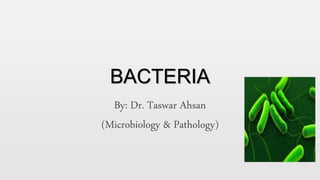
Bacteria
- 1. BACTERIA By: Dr. Taswar Ahsan (Microbiology & Pathology)
- 2. He was a Dutch Biologist First time discovered bacteria in 1676 Reported this discovery to the Royal Society of London in the year 1683 He described these microscopic organisms as “Streaks and Threads”. Later on some workers gave them the name “Animalcules”. The name bacteria were given by a German biologist Christian G. Ehrenberg in 1828 No doubt, the word Bacteria appeared from time to time in scientific writing, but it was not until the fermentation experiments of Louis Pasteur C hrist ian G. Ehrenberg
- 3. Louis Pasteur that the bacteria took a renewed significance He also discovered that bacteria were cause of some diseases This fact was called “Germ Theory of Disease”. The famous “Koch’s Postulates” of the German Physician Robert Koch (1843-1910) were based on the studies on disease causing bacteria. Later bacteria came to be regarded as plants by many biologists and were classified under the name “Schizomycetes”.
- 4. Avery, Macleod and Mc Carty in 1944 established the role of DNA as genetic material by using bacterial transformation as evidence. Later on, Lederberg and Tatum in 1946 described genetic recombination through their experiment on bacterial conjugation.
- 5. • 1.Bacteria (Eubacteria) are the smallest and structurally the simplest, not only of all plants, but of all living organisms. They occur in all places where ever life is possible. • 2.Since they possess rigid cell wall, they are considered to be plants. • 3.They are typically unicellular, rarely exceeding 3 to 5 microns in length. • 4.Since they lack distinct nucleus, nucleolus and nuclear membrane, they are prokaryotes like blue green algae.
- 6. • 5.They also lack membrane bound organelles like endoplasmic reticulum, Golgi bodies, mitochondria, plastids et. Because of these features, bacteria are now grouped with blue green algae in their own kingdom Monera or Cyanobacteria. • 6.Majority of bacteria lack chlorophyll and hence are heterotrophic. Those, who possess chlorophyll, are autotrophic. They are mostly parasites or saprophytes. • 7.Genetic material is present in the form of histone-free DNA. • 8.They mostly reproduce vegetatively or asexually. However, some sort of Genetic Recombination has also been reported in some cases. • 9.Bacteria can exist even in the absence of oxygen, and withstand temperature as low as -17 0C and as high as 80 0C. • 10.Bacteria have been found at depths of many meters in soils and also in ooze beds, far below the surface of the sea.
- 7. 1.Coccus form (GK. Kokkos=berry) These are spherical or ovoid. When they occur singly they are called Micrococcus (monococci), when in two-Diplococci, when in four- Tetracocci, in chains Streptococci, in irregular clusters Staphylococci and when in three dimensional forms they are referred as Sarcinae. 1 Bacillus form They are cylindrical or rod-shaped. The bacilli may occur singly or in groups. Depending upon the form of grouping they may be called Diplobaccillus, Palisadebacillus and stertobacillus. The stretobacilli may be branched (e.g. Cladothrix) or unbranched (e.g. B. subtilis). 2 Spirillum form They are spiral in shape. Mostly they look like a corkscrew. They do not aggregate or form colonies. 3
- 8. Filament form They are thread- like in form. They take various morphological forms, such as: Vibrio, Mycelia, Stalked, Budding 1 Pleomorphism Some bacteria occur in multiple forms, and are called plemorphic bacteria. For instance Rhizobium leguminosarum occurs in three forms, viz, rod, oval swarmers and irregularly branched (bacteriods). 2
- 9. Gram Positive Bacteria Gram Positive Bacteria take up Gram stain have thicker cell wall (100-200 A); their cell membrane becomes invaginated inside the cytoplasm and form mesosomes; they lack pili or fimbriae. 1 Gram Negative Bacteria Gram negative bacteria do not take up Gram stain, have thinner cell wall (70-1220A); cell wall is more complex and contains about 20% lipids; mesosomes are not formed; and they bear pili. Majority of the pathogenic bacteria are Gram negative. 2
- 10. Property Gram-Positive Bacteria Gram-Negative Bacteria Gram Staining Takes stain Does not take stain Cell wall Thicker cell wall(100-200 A) Thinner cell wall(70-120 A) Cell membrane Forms mesosomes Mesosomes not formed Pili or fimbriae Absent Present Streptomycin susceptibility Less susceptibility More susceptibility Susceptibility to lysozyme More susceptibility Less susceptibility Types of toxin produced Exotoxin Enaotoxin Amount of cell wall lipid Low High Mesosome in cytoplasm Present Absent Nutritious requirement Relatively complex Relatively simple Typical bacteria Spore forming rods Few cocci